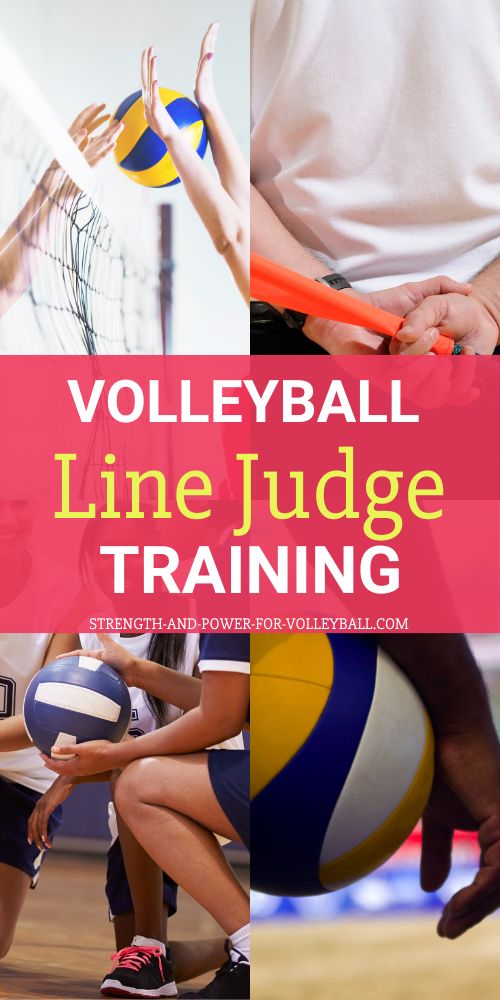How to Line Judge Volleyball
Tips for Line Judges
How to line judge volleyball. Learn the tips and tricks to line judging volleyball matches.
Responsibilities of Line Judges
To be successful at line judging, you need to know your responsibilities.
Pre-match. The line judge needs to show up before the match to take instructions from the officials. Before the match starts, the referees will have a meeting with the line judges to go over the line judge responsibilities.
During the Match. Know what you are suppose to do during the match. The line judges need to communicate with the officials during the match. The line judges communicate by making signals. The line judge will signal what they see. If the line judge didn't see what happened or are unsure what to call, the line judge will make a signal by crossing the arms in front of their chest. This will signal they didn't see what happened. The referee will then know the line judge isn't making a call. The referee will then decide to either make the call themselves, get help from another official or line judge or end up calling a replay.
Post-match. After the match is completed, the officials will thank the line judges and the rest of the work crew.
Signals - How to Line Judge Volleyball
Here are the main signals for line judges.
- "in"
- "out"
- "touches"
- "foot faults"
- "ball hits the antenna"
- "ball crosses outside the antenna"
- "ball hits object out of play"
- "impossible judgement"
Line Judge Signals - How to Line Judge Volleyball
The following are the signals for line judging volleyball.
IN. Point the flag down. This is the signal for when the ball lands on the court boundary lines or inside the court boundary lines.
OUT. Raise the flag vertically. This is the signal for when the ball lands outside the boundary lines. This is also the signal for when the ball contacts any object outside the court. The antenna, the net outside the antenna, the pole and cables attached to the net are all "out".
TOUCH. To signal touch, raise the flag and touch the palm of the opposite hand on top of the flag. The touch signal is for when the ball is touched and then lands out of play. Touches usually occur when a player is passing or playing defense and the ball deflects off an arm. The other common situation for touches is when the ball is deflected off a player blocking at the net. The ball deflects off the hands or arms and lands out of play. For the balls that are touched and land inside the court, the signal to use is the "in" signal. Only signal "out" for balls that land out of play or hit an object out of play. For a ball that's hit into the net and doesn't cross the net then lands out of bounds, the line judge should never signal "touch" in this situation (even if the blocker touches the ball). The only time the line judge should signal touch is when the ball crosses the net and lands out of bounds (after the ball is touched by a player). So, if it's touched and doesn't cross the net, signal "out". If the ball is touched, lands "out" and has crossed the net, signal "touch".
CROSSING SPACE SIGNAL. When the ball crosses the space outside the antenna, the line judge will raise the flag and wave the flag in the air while pointing the finger to the antenna. This signals to the officials the ball is "out".
FOOT FAULT SIGNAL. The line judge needs to watch for the server stepping on the end line when serving. If the server steps on the line, the line judge will waive the flag and point to the line to signal to the referee.
IMPOSSIBLE JUDGEMENT. The line judge will signal "impossible judgement" for situations where they weren't able to make a good judgement. This signal is done by crossing the arms in front of the chest. The referee doesn't want the line judge to ever guess. Never guess what happens. Only signal when you are sure you know what happened.
During Timeouts and In Between Sets
The line judges will move to a different area during time outs and in between sets.
For USAV, the line judges will stand at the center of the endline during a time out. When team returns to the court, the line judge will return to their position.
For college and high school volleyball competition, the line judge will move to stand at the intersection of the 3 meter line and side line on the first referees side of the court.
It's important to mention the line judges shouldn't enter the court at any time. If the line judge needs to move to an area on the other side of the court, the line judge should walk around the outside boundary lines of the court to avoid walking through the court.
The line judges should get instructions from the referee for where to stand in between sets. Most of the time, the line judges should return to the scorers table area between sets.
At the end of the match, the line judges return the flags to the referee or scorers table. After the referee thanks the line judges, the line judges are free to go.
If you enjoyed these tips on how to line judge volleyball and would like to keep it close to you at any time, just save this pin to your Pinterest Volleyball Training Board.
- Home
- Officiating
- How to Line Judge Volleyball
